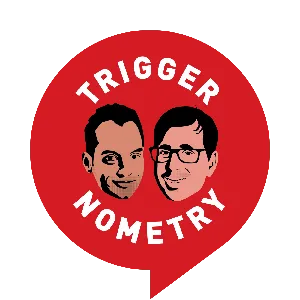Podcast Summary
Exploring the dangerous world of Fentanyl trafficking and the opioid crisis: The illegal Fentanyl trade is intricate and global, fueling the opioid crisis through the use of precursor chemicals and contributing to devastating consequences for individuals and communities.
Intricate and dangerous nature of the black market for illegal drugs, specifically Fentanyl, and how it connects to the opioid crisis in America. The podcast "Traffic'd," hosted by Marianna von Zeller, takes listeners on a raw and provocative journey into the world of trafficking rings and shadow economies. In the first episode, listeners meet country rapper Struggle Jennings, who shares his personal story of addiction and involvement in the opioid trade. The episode highlights the role of precursor chemicals, like those found in the barrels off the coast of Mexico, in the production of Fentanyl. The discussion underscores the complexity and global reach of the black market for illegal drugs and the devastating consequences for individuals and communities.
Waylon Jennings' influence on interviewee's life: Growing up with Waylon Jennings' music, the interviewee learned valuable lessons but also turned to drugs to cope with their father's death at a young age, shaping their upbringing and personal development.
Waylon Jennings, despite being an outlaw and breaking the norms of country music, served as a significant inspiration in the interviewee's life. They grew up with him, learning valuable lessons that both positively and negatively influenced their future. Tragically, the interviewee's father, who was also a crucial figure in their life, passed away when they were 10 years old. This event led the interviewee to experiment with drugs at a young age as a way to cope with their loss and feelings of regret. Ultimately, these experiences shaped the interviewee's upbringing and personal development.
Privileged backgrounds and drug trafficking: Despite a privileged background, lack of opportunity and allure of wealth can lead anyone into dangerous activities like drug trafficking, even if they initially start small
Lack of opportunity and the allure of wealth and lifestyle can lead some individuals, even those from privileged backgrounds, into the dangerous world of drug trafficking and dealing. The speaker, who was the grandson of a wealthy family, started selling weed at a young age due to his mother's determination to make it on her own and the stark contrast between his two worlds. However, the profit and glamour of the drug trade proved to be irresistible, leading him to graduate to more serious crimes like robbery. Despite the risks, the speaker didn't fear getting caught as he believed he was invincible. This is a reminder that circumstances and desires can lead anyone down a dangerous path, regardless of their background.
Fear and Curiosity's Impact on Life Choices: Fear and curiosity can significantly impact life choices, with fear potentially preventing dangerous decisions but also allowing for regrettable ones, while curiosity can lead to new opportunities or dangerous paths. External factors like law enforcement and societal norms can also influence these choices.
Fear held back five friends from making a dangerous decision, but it didn't stop the speaker. This decision led him down a path of drug dealing, which eventually landed him in jail. Later in life, he pursued a career in music, but the allure of prescription painkillers derailed his efforts. The speaker's story illustrates how fear and curiosity can significantly impact one's life choices, and how external factors like law enforcement and societal norms can influence those choices as well. Additionally, the discussion highlights the growing issue of prescription drug abuse during the early 2000s, particularly in Tennessee.
The Role of Pain Clinics in Fueling the Opioid Crisis: The lack of oversight in pain clinics led to their function as drug dealing operations, contributing to the opioid epidemic's scale and involvement of various players including manufacturers, distributors, and dealers.
The opioid crisis emerged as people who were addicted to prescription painkillers turned to the black market for supplies. This was facilitated by the lack of oversight in pain clinics, which functioned as drug dealing operations. The speaker, Marianna Van Zeller, shares her personal experience of buying and selling large quantities of opioids, which came directly from the manufacturer before they even reached pharmacies. At the time, she had around 15-20 dealers selling for her, and she was making about $20 a week from selling 10,000 pills. This underscores the scale of the problem and the role that various players, including manufacturers, distributors, and dealers, played in fueling the opioid epidemic.
Personal story of opioid addiction and its consequences: Opioid addiction can start from legal prescriptions and lead to dangerous consequences, causing physical and mental dependence, overdoses, and even deaths. It's crucial to be aware and seek help if you or someone you know is struggling.
Opioid addiction can start with legitimate prescriptions but can quickly spiral out of control, leading to dangerous consequences. The speaker in this discussion, named Struggle, shares his personal experience of becoming addicted to hydrocodone and oxycodone pills, which he sold to make money. He describes how easy it was to become physically and mentally dependent on the drugs, and how difficult it was to quit. Struggle also witnessed the devastating effects of opioid addiction in his community, including overdoses and deaths from larger doses like OxyContin. It's important to be aware of the potential dangers of opioids and to seek help if you or someone you know is struggling with addiction. Opioids are responsible for nearly half of all drug overdoses every year, and it's crucial to take them seriously and avoid getting drawn into the cycle of addiction.
The allure of profit and peer pressure can lead individuals into risky drug deals: Profit and peer pressure can override personal beliefs and lead to dangerous drug deals, involving uncertainties and potential losses, as well as the presence of superstitions and rituals in the drug trade.
The pressure to adapt to changing market demands can lead individuals into making risky decisions, even if they have previously sworn off certain substances. In this case, a drug dealer, despite his reservations about selling OxyContin, gave in to the persuasion of his friends and the potential profit. However, the transaction turned out to be a setup, resulting in a loss for him. The incident serves as a reminder of the dangers and uncertainties associated with the drug trade. Additionally, the use of Jesus Malverde candles as a mandatory requirement by the dealer's supplier highlights the role of superstition and rituals in the drug world.
Personal story of drug dealing and its consequences: Glorifying drug dealing and use comes with severe consequences, including loss of loved ones, fleeting wealth, and addiction. Seek other opportunities instead.
The glamorized lifestyle of drug dealing and drug use comes with devastating consequences. The speaker shares his personal experience of being caught in a drug deal, leading to a 57-month sentence in federal prison. He emphasizes the harsh realities of the drug world, including the loss of loved ones and the fleeting nature of any wealth gained. Despite the allure, the speaker warns against glorifying this lifestyle and encourages those who may be tempted to seek other opportunities instead. He also shares the ongoing struggle with addiction and overdoses in his community, acknowledging the weight of responsibility he carries for his role in it.
Struggle Jennings's music evolution: Struggle Jennings transformed his image from an outlaw country rapper promoting negative lifestyles to a professional musician with a broad fan base and major social media following, while staying true to himself and inspiring positive change.
Struggle Jennings, despite his image as an outlaw country rapper, has worked to separate his music from promoting violence, drugs, or negative lifestyles. He's made a conscious effort to clean up his message in his songs and has found success as a musician, owning his own record label and having a broad fan base and major social media following. He's a professional recording artist and now makes more money, though it comes with the responsibility of paying taxes. Despite the shift in focus, he remains authentic to himself and his past experiences, which resonates with his audience. It's a reminder that one can use their experiences to create art while also striving for positive change.






